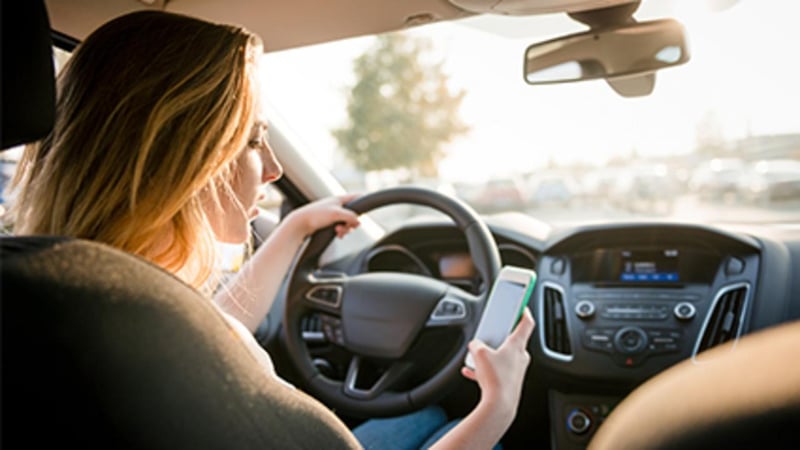Get Healthy!

- Cara Murez
- Posted April 3, 2023
Half of U.S. Drivers Say They Often Use Cellphones Behind the Wheel
Texting and driving can be deadly. Holding your phone in your hand to talk and surfing the internet while behind the wheel is dangerous, too.
This is widely known, but a new survey finds that about half of all respondents still use an electronic device most or every time they drive.
"I'd say it's not as much surprising as it is frustrating,"said Adam Snider, a spokesman for the nonprofit Governors Highway Safety Association (GHSA), which wasn't involved in the study but issued a news release after it was released. "Distracted driving is something that is incredibly pervasive."
In the survey, conducted by the Insurance Institute for Highway Safety (IIHS), more than 2,000 licensed drivers were asked how much they agreed with dozens of statements designed with the Health Belief Model in mind.
That model is described as a behavioral change theory developed to understand why some people don't adopt a certain health behavior. It's usually applied to illness or disease prevention, according to the study.
"I think the results from this study really help shed some light on the reasons why"people are still using their phones in their cars, said lead author Aimee Cox, a research associate with the IIHS.
Cox said that appears to include "the need or the perceived need to respond to family or friends, the need for information, all these things that modern cellphones have really allowed us to do without thinking about it."
While distracted drivers are using their phones while driving because they don't want to miss a call from their kids, for example, it's also their family members who they say could motivate them to put the phones down.
"I think that provides a really unique opportunity to where if we can encourage that open and safe communication and dialogue, we can have teen drivers and kids encouraging their parents to practice safe driving behaviors and vice versa. I think it needs to go both ways,"Cox said.
Distracted drivers killed at least 3,000 people in 2020, according to a statement issued by GHSA CEO Jonathan Adkins. That was 8% of all traffic deaths.
Another 400,000 people are injured each year, Snider said, but it may very well be higher, because it can be hard to prove that distracted driving caused a crash.
"This is something that every person who gets behind the wheel has the power to turn off their phone, to put their phone down, to put it in the glove box, to connect through in-vehicle technologies,"Snider said.
It takes about five seconds to read or send a text message, Snider noted. At 55 miles per hour, that's 130 yards without once looking at the road, he said.
You're essentially driving the length of a football field, end zone to end zone, without once seeing the road, blindfolded, which is incredibly dangerous,"Snider said.
Public awareness is important, he added.
It took a long time to finally make drinking and driving socially unacceptable, he noted. Snider also pointed to the progress made in getting people to wear seatbelts. Public awareness campaigns and people encouraging each other are among the factors that eventually helped.
"Thinking about seat belts, it can take a long time to have this culture change, but the safety impacts can be huge when we make it the expected norm that someone either buckles up or puts their phone down,"Snider said.
An earlier analysis found that parents of children ages 18 and younger were among the top offenders of driving distracted, Cox said.
"That was interesting, but, again, not surprising because you're managing a busy lifestyle,"Cox said.
Among the questions researchers posed to those surveyed: What impact it would have if their family or friends reminded them that they could hurt or kill someone with distracted driving.
"Those were all messages that people indicated in our sample that if they heard from someone that they cared about saying those sorts of things to them, that would be really motivating,"Cox said.
Those surveyed also said they could be motivated by policy changes, including increased and tougher enforcement of distracted driving laws. A majority also said they would support this, not just be motivated by it.
"There's not just one easy fix,"Cox said. "We're going to have to increase threat perceptions and find solutions to the common barriers, while also implementing these cues to actions like communicating with family and friends or these policy-level cues."
It's not just drivers and their passengers who are being injured or killed because of distracted driving, Snider said. It's also pedestrians and bicyclists.
"Everyone can play a role in this. This is not a problem that's unsolvable,"Snider said.
More information
The National Highway Traffic Safety Administration has more on traffic deaths.
SOURCES: Aimee Cox, MPH, research associate, Insurance Institute for Highway Safety, Arlington, Va.; Adam Snider, BA, director of communications, Governors Highway Safety Association, Washington, D.C.; "Applying the Health Belief Model to Mobile Device Distracted Driving,"March 2023
